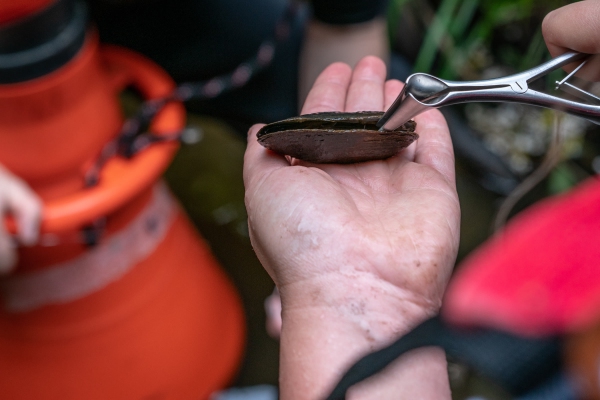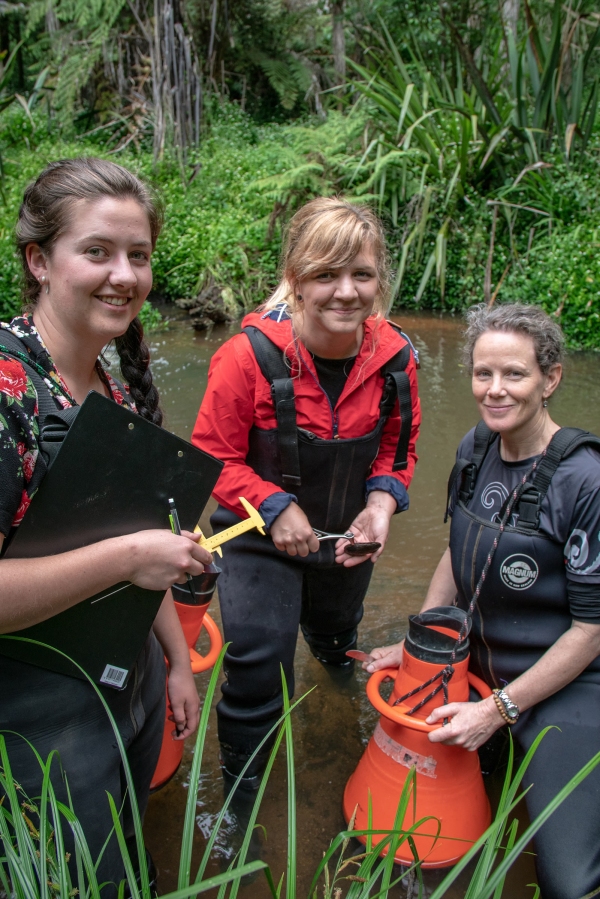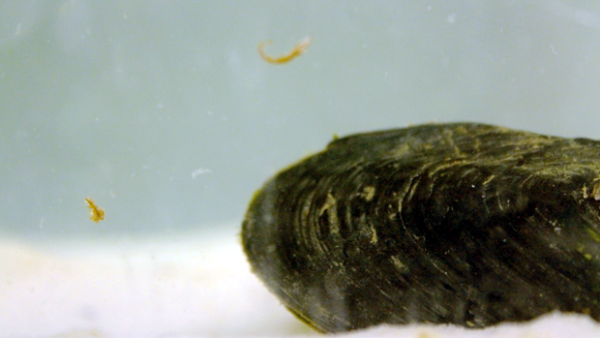NIWA scientists have made an important breakthrough in the battle to save New Zealand’s freshwater mussels.
Kākahi were once a valuable food source for many Māori and also play a crucial role in waterways, but each of the three species native to New Zealand have been in decline for a number of years probably due to pollution and structures that impede fish movement.
Now, Michele Melchior, a University of Waikato doctoral student, has discovered that the species use different reproductive strategies that may help them live side-by-side without competing for resources.
It is a breakthrough that NIWA freshwater scientist Dr Sue Clearwater – who has been leading research into kākahi for the last few years, says the discovery will help push forward restoration and conservation of these incredible animals.
“Mussels are biofilters and bioturbators (like earthworms) – they change the cycling of nutrients in the environment and influence how the whole ecosystem is shaped.”
“If they are present in large enough numbers they can filter the entire volume of a small lake within days. But we are concerned that we are losing them from our shallow lakes and streams just as we discover how special they are.”
All kākahi were thought to reproduce by releasing clouds of larvae into a waterway. The larvae attach themselves to passing fish and hitchhike upstream to a new habitat where they fall off, settle and grow. They transform from a larva into a juvenile mussel during this parasitic hitchhiking phase.
But Michele Melchior has discovered that is not the case for the larger Echyridella aucklandica species, which might live to be well-over 50 years old. Mostly found in the Waikato northwards but dying out faster than their counterparts, this species releases their larvae in enticing packages called conglutinates, like fly-fishing lures to attract certain fish species.
“As far as we know, this is the first known freshwater mussel species outside of North America to using these lures that mimic fish food items, as a strategy to attract and attach to fish.”
The lures are between 5 and 9 mm long, look like a small flatworm, and carry on their back about 200 tiny larvae, each about the size of a grain of sand. Fish that are attracted to the lures try to eat them, giving the larvae, shaped like pac-men, a chance to attach to the gill. Once on the fish they can then transform into juveniles, and catch their all-important “ride” to new habitat, probably upstream and in cleaner waters than where the adults live.
“This is the species that is dying out first in our shallow lakes and streams and we don’t really know why,” Dr Clearwater says. “We suspect that it’s because of contaminants, including silt, and possibly because of a lack of their fish host”.
Michele’s PhD is part of the research programme called Cultural Keystone Species funded by the Ministry of Business, Innovation and Employment (MBIE) and the next step is to understand which fish are most attracted to the lures.
The next stage of the team’s research is to understand which fish are most attracted to the lures.
“We can use this information to develop restoration methods to make sure the fish hosts are available, and it may also help use develop captive rearing methods so that we can then restock them to help restore this threatened species.”
Already work led by NIWA has succeeded in producing large quantities of juveniles of the more common Echyridella menziesii species in the lab but as yet only small numbers live beyond two months old.
New research funded by the Ministry of Business, Innovation and Employment Smart Ideas fund, will work on that problem as well as focus on the use of mussels in rehabilitating nutrient-rich shallow lakes plagued by silt, nutrients, algae and cyanobacterial blooms.
Scientists will trial a system where mussels are lifted from the bottom of a lake and placed on rafts to help them filter and clear the water column. Field trials will take place over summer at Lake Ohinewai, in north Waikato with the assistance of the local hapu.
“We are also doing laboratory investigations to make sure the mussels can survive on the rafts, and to better understand how to optimise their impact on water quality”, Dr Clearwater says.
“Long-term we might be able to use mussel rafts to improve treated stormwater quality because they can degrade bacteria. Mussels might help make water more 'swimmable'.”
She also says that because mussels improve water quality and biodiversity, and they are strongly linked to fish, fish conservation will help with the conservation of mussels which is a win-win.
“Mussels live a long time and they’re very important to our waterways. It’s crucial we look after them.”
Dr Clearwater admits to developing a fondness for kākahi despite describing them as the “cabbage of the aquatic world” – okay to eat but probably not the most favoured of foods.
“There’s something quite primal about collecting nice big mussels from a stream, just like collecting tua tua at the beach. Also the adults can be old and tough, but the juveniles are so sensitive. That’s what makes them so fascinating.”
Kākahi are often found tucked under banks, in shady pools and partly submerged in shady, soft-bottomed streams. “You can check them out but don’t leave them out of the water for long – and put them back where you find them.”




